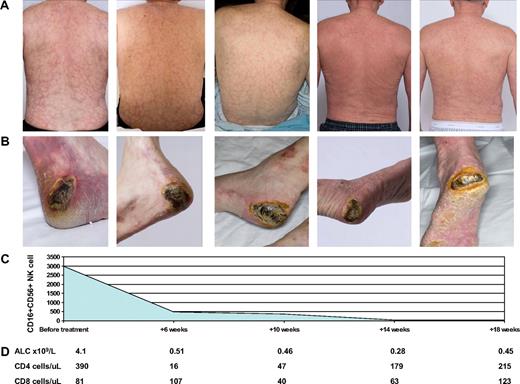To the editor:
We describe the first case of chronic natural killer (NK)–cell lymphocytosis (CNKL) successfully treated with alemtuzumab. Our patient is a 62-year-old male diagnosed in 2007 with livedo reticularis, cutaneous polyarteritis nodosa, and peripheral neuropathy. No hepatosplenomegaly was present. Complete blood count showed leukocytosis 14.6 × 109/L (normal, 3.5-10.5 × 109/L), with predominant lymphocytes 8.91 × 109/L (normal, 0.9-2.9 × 109/L). Hemoglobin, platelet count, renal and liver function, autoimmune panel, and T-cell gene rearrangement studies were otherwise normal. Peripheral smear revealed large granular lymphocytes. Peripheral blood flow cytometry showed 82% of lymphocytes consisted of CD3−, CD16−, and CD56+ NK cells with aberrant CD8 expression. On immunophenotyping, the cells lacked killer cell immunoglobulin–like receptor (KIR) antigens CD158a, CD158b, and CD158e (p70). This abnormal clone persisted on repeat flow cytometric testing. A trial of high-dose corticosteroids and methotrexate failed to control symptoms and NK-cell population.
His symptoms progressed with worsening livedo reticularis (Figure 1A) and lower extremity neuropathy, and development of multiple painful skin ulcers on his face, arms, legs, and feet (Figure 1B), requiring opioid analgesia and a wheelchair to mobilize. Sural nerve biopsy was suggestive of vasculitis and the abnormal NK-cell clone expressing CD52 was increased.
Measurement of CD16+CD56+ NK cells, lymphocyte count, and clinical features during treatment with alemtuzumab. Treatment of CNKL with alemtuzumab effectively improved livedo reticularis (A) and cutaneous ulcers (B), and this correlated with a decrease in CD16+CD56+ NK cells (C) and reconstitution of the total lymphocytes (D). ALC indicates absolute lymphocyte count.
Measurement of CD16+CD56+ NK cells, lymphocyte count, and clinical features during treatment with alemtuzumab. Treatment of CNKL with alemtuzumab effectively improved livedo reticularis (A) and cutaneous ulcers (B), and this correlated with a decrease in CD16+CD56+ NK cells (C) and reconstitution of the total lymphocytes (D). ALC indicates absolute lymphocyte count.
Alemtuzumab was started at 10 mg by subcutaneous injection, thrice weekly. Treatment was well tolerated and after 14 weeks, the decline in NK-cell population correlated with improvement of the livedo reticularis, healing of multiple skin ulcers, and complete resolution of his neuropathic pain, allowing him to ambulate independently (Figure 1C). Alemtuzumab was reduced to 10 mg twice weekly. After 18 weeks of treatment, the abnormal NK-cell clone was absent and reconstitution of the total lymphocytes was observed (Figure 1D). Alemtuzumab was reduced to 10 mg weekly and the patient has been maintained on this dose. Due to increased risks for opportunistic infections during treatment with alemtuzumab, the patient received sulfamethoxazole/trimethoprim and acyclovir for prophylaxis against Pneumocystis jiroveci and herpesvirus infections, respectively. Weekly surveillance for cytomegalovirus by rapid polymerase chain reaction on plasma was also performed. The patient did develop cytomegalovirus viremia during treatment, which was successfully treated with valganciclovir.
CNKL is an indolent NK-cell disorder with persistent NK-cell proliferations.1 Cutaneous and peripheral nerve vasculitis and peripheral neuropathy associated with CNKL have been reported previously.2 It has been postulated that the lack of inhibitory KIR expression (CD158a, CD158b and CD158e) on the aberrant NK-cell population, as seen in our patient, may have led to unopposed NK-cell activation and consequent vascular inflammation, a phenomenon also seen in rheumatoid vasculitis.3 Treatment is instituted when the patient is symptomatic or cytopenias are present. This has included immunosuppression with corticosteroids, cyclophosphamide, cyclosporine, and methotrexate.2 As our patient failed therapy with corticosteroids and methotrexate, we considered the use of alemtuzumab, a humanized monoclonal antibody against CD52 antigen, in view of the fact that CD52 is expressed on NK cells and there were increasing reports in the literature of T-cell large granular leukemia treated with alemtuzumab.4 We conclude that alemtuzumab is an effective treatment for CNKL, but further studies should be encouraged based on this experience.
Authorship
Conflict-of-interest disclosure: The authors declare no competing financial interests.
Contribution: C.E.C. analyzed the data, performed the research, and wrote the case; and K.J.W. and A.T. provided supervision.
Correspondence: Ayalew Tefferi, MD, Mayo Clinic, 200 First St SW, Rochester, MN 55905; e-mail: tefferi.ayalew@mayo.edu.


This feature is available to Subscribers Only
Sign In or Create an Account Close Modal